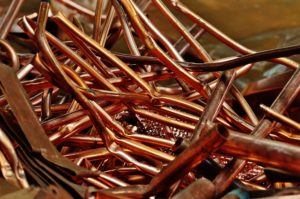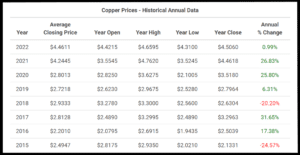Copper is often thought of as a precious metal, but it is actually classified as a base metal
While it may not have the same value as gold or silver, copper is still considered to be valuable. In fact, it has many unique properties that make it a sought-after material in a variety of applications.
Here’s a closer look at why copper is so special and why it continues to be in high demand.
Copper is not a rare metal and is frequently used in industry, jewellery and art.
It’s also abundant enough to be considered a transition metal (a metal that does not possess specific properties but lies between metals with those properties).
Copper has been mined for at least 10’000 years.
Early civilizations discovered the usefulness of copper by using it as a road to the other metals, such as gold and silver.
Copper is one of the first metals to have been used by humans.
Copper is often found in its native state or alloyed with other metals.
The metal forms a blue oxide coating when exposed to air, which slowly converts to a green surface patina. It is also used in sculpture due to its malleability.
Copper Is a Thermal and Electrical Conductor
Copper is an excellent thermal and electrical conductor, which has made it one of the most important metals today.
Copper can be alloyed with other metals to form bronze which is much stronger than copper.
What Are the Most Common Uses For Copper?
Copper is an excellent thermal and electrical conductor, which has made it one of the most important metals today.
|
The main use of copper is in electrical applications, for which demand has increased rapidly (+5.6% per year since 2000).
Other common uses are the production of heat exchangers, containers for beverages and food, electricity generation, and high-speed trains. Copper is also commonly used in jewellery.
Who is the biggest producer of copper?
Chile has 31% of the world’s known copper reserves. The other major producers are China (13%) and Peru (10%).
About 6 million tonnes out of Chile’s annual production of over 8 million tonnes comes from the giant Escondida mine in Chile.
What are the effects of mining on the environment?
Copper mines have a serious impact on the local environment, as they require excavation of large quantities of rock to extract the metal.
The actual process of ore extraction generates a significant amount of waste material which can cause contamination if not properly managed.
However, modern mining is subject to strict environmental and safety rules. Mining companies are required by law to clean up the land after the mine has been exhausted.
Can Copper be Recycled?
Recycling old electrical appliances like wires, cables, and radiators is not only environmentally friendly but also economically attractive.
The recycling process can recover 80 – 95% of the metal content of waste materials for new products.
However, recycling of copper is often more complicated and energy-intensive than mining and extracting the metal from the ore (it requires melting it down).
Many recyclers also claim that recycled copper generally has a lower quality than ‘virgin’ copper due to impurities that accumulate in melted metals during the recycling process.
What are Some Alternatives to Using so Much Copper?
Copper has a high thermal and electrical conductivity which makes it an indispensable metal in electricity generation and electronics.
However, scientists have been looking for ways of replacing the use of pure copper with green alternatives such as those made from recycled materials.
In order to reduce the consumption of copper and other metals and minerals, we need to improve recycling rates.
The development and application of renewable energy sources offers a good opportunity for us to use less metal in our everyday lives since it is estimated that 25% of global electricity production could be based on renewable energy sources by 2022.
Can You Reduce the Effects of a Copper Mine on the Environment?
Efforts should be made to minimise environmental damage by implementing stricter safety procedures, using clean production technology and investing in post-mine restoration.
These steps will not only minimise environmental degradation but also make mining more sustainable.
How much copper is produced worldwide?
Copper demand has grown with the increase in global population and rapid industrialization.
The world’s major producers of copper are
Chile (31%),
China (13%) and
Peru (10%).
The demand for copper in Europe is estimated to grow by 1.7% per year.
That’s 11,1 million tonnes!
What is the Average Price of Copper?
Does Copper Have any Value as a Form of Currency like Gold does?
Copper is a comparatively cheap metal, so it could have been used as currency at one point in time.
However, there are several problems with using copper as currency. One main problem is that the value of copper fluctuates much more than the value of gold does.
This makes it difficult to determine how much copper should be worth at any given time.
Another issue with the use of copper as money has to do with wear and tear on coins that are in circulation for long periods of time.
Copper coins would quickly become too thin to be recognized by people who were used to seeing thicker, gold coins.
There are a few cases of copper being used as money, but not on a large scale.
One example of this is the U.S. penny – one-cent coins used to be made from 95% copper and 5% zinc, but they have since been replaced with cheaper metals that keep the price of the coin down while still allowing it to be recognized by vending machines and other automated systems that require payment.
In some parts of Asia, however, copper was actually used as the primary form of currency for hundreds of years before it was replaced by paper money.
In China in particular, a standardized “copper cash” coin began circulating around 1200 BCE and continued until about 200 CE, which is around the time paper bills started being introduced.
Below are the Top 4 Precious Metal firms that we have chosen, as being amongst the most reputable Gold IRA companies in the industry.
Click here to read our reviews

|
The Bottom Line
Copper is not a precious metal on its own, but it can be considered as such if combined with other metals.
The price of copper fluctuates depending on the international market and economic conditions. It has been used in coins all over the world for centuries because of its durability and affordability.
If you’ve been debating whether copper is a precious metal or not, this article should help clear up your confusion.
Copper has many industrial and commercial uses that make it an important material to the world economy. But what about its place in our culture?
Does copper have any value as a form of currency like gold does?
The answer may surprise you! When we look into how society views copper, we see that some cultures consider it valuable while others do not.
In fact, there are no countries on earth where people use pure copper coins at all times—either for trade with other currencies or for government-issued money systems.







